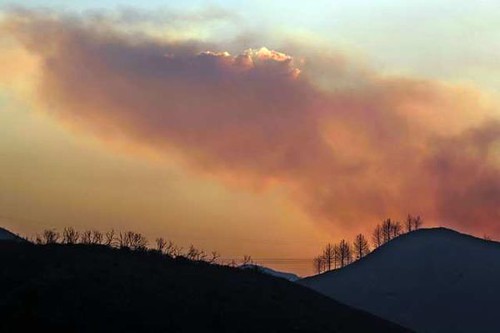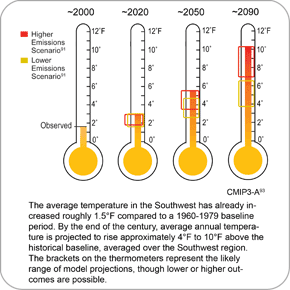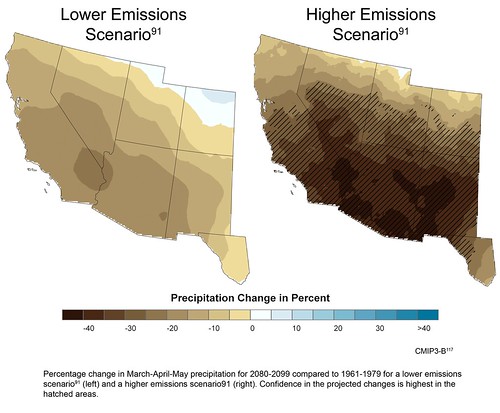( – promoted by Robert in Monterey)
 They’re Baaaaack! (Cross-posted from OpenLeft, thanks to a gentle nudge from Lucas O’Connor.]
They’re Baaaaack! (Cross-posted from OpenLeft, thanks to a gentle nudge from Lucas O’Connor.]
I live in Long Beach, walking distance from San Pedro Bay, the southern edge of the Los Angeles Basin, and today there are wildfires raging on the other edge of the Los Angeles Basin. Over 100 houses have been evacutated, and over 2,000 acres burned so far. I can look out my window as I type this and see the smoke. It’s not as bad as the fires one month ago. But it’s a stark reminder of quickly and easily those fires could return. So I’m going to republish an article I wrote about the fires for Random Lengths News.
The image below combines a satelite photo of the fires from last month with Dorothea Lange’s “Migrant Mother.” She was a refuge from the most famous megadrought of the last century. But there’s been much worse centuries ago, and there’s much worse to come, according to scientists I spoke with.
Story begins on the flip…
The Fire This Time, Next Time, And The Time After That…
It’s not that global warming caused the latest round of wildfires, it’s that they tell us what’s coming. And even now we’re not handling it well.
By Paul Rosenberg, Senior Editor, Random Lengths News
The blast furnace of Santa Ana-driven wildfires has receded, but three things are certain: First, they’ll be back. Second, it will be sooner, rather than later, and with increasingly intensity. Third, we won’t be prepared.
An Associated Press story, titled “Global Warming Could Worsen California Wildfires,”began: “Drought- and beetle-ravaged trees in this mountain community stick up like matchsticks in the San Bernardino National Forest, bypassed by the fires still smoldering, but left like kindling for the next big blaze. Welcome to the future.”
The story was written in 2003.
But even then, it was old news, whether AP new it or not. We are already two decades into that future, according to a study published in Science magazine three years later, which examined every forest fire that burned at least 1,000 acres in “federal land-management units containing 61% of western forested areas.” Out of 1,166 fires in that period, four-fifths of them-about 900 fires-occurred after 1987, a period in which the average fire season length increased by 78 days, almost equally due to starting earlier and ending later.
That explosion in the number of fires is matched by increases in size. On CBS’s 60 Minutes on Sunday, October 21, Tom Boatner, chief of fire operations for the federal government, said, “Ten years ago, if you had a 100,000 acre fire, you were talking about a huge fire. And if we had one or two of those a year, that was probably unusual. Now we talk about 200,000 acre fires like it’s just another day at the office. It’s been a huge change.”
Despite the growing threat, which global warming will only intensify, California has done very little to prepare itself since the 2003 wave of fires, and no place has done less than San Diego County, home to noted social critic Mike Davis.
“Since I published The Ecology of Fear, a lot of the fire scientists’ views have almost become conventional wisdom among firefighters and the public, but it doesn’t make much difference,” Davis told Random Lengths.
“There was a sense of optimism after the 2003 fire, when people thought some kind of change was possible, but everything was shot down. It was crushed by development money at the polls,” Davis added. “The grand jury urged the creation of a county fire department, that was never implemented. The [San Diego] city fire chief quit in frustration.”
Ronny Coleman is one of America’s top firefighting professionals, and his views are strikingly similar to Davis’s. He formerly served as California State Fire Marshal and retired as Chief Deputy Director of the California Department of Forestry and Fire Protection. Earlier he served as Orange County Fire Chief.
“Every tax bond issue put before San Diego County voters was voted down in the aftermath of the fires. You don’t have adequate resources if you’re not willing to pay for it,” Coleman said, flatly.
“Every asset that is not there in the first 8 hours is a deficiency of some kind. But if the people are unwilling to pay for that at the local level, why should Orange County or Los Angeles County or any other county be taxed for it?” he asked, pointedly.
Coleman served on Governor Schwarzenegger’s Blue Ribbon Fire Commission which developed an action plan in the months following the 2003 fires. But in May of this year, the LA Times published a blistering criticism of failed follow-through on crucial aspects of the plan. According to the Times:
- The state remained “far short of the 150 additional engines recommended to supplement the governor’s Office of Emergency Services fleet of 110,” with the first of 19 new engines due for delivery by July.
- The state’s aging fire helicopters-built in the 1960s-needed to be replaced. But no new choppers had been purchased.
- A national contract fleet of heavy air tankers remained at less than half of what it had been five years earlier- 16 compared with 41.
- The Times noted that the legislatures passed four bills “to increase staffing and add fire resources, at a cost of tens of millions of dollars,” but Schwarzenegger vetoed them.
There was no mention of his neglect as Schwarzenegger toured the San Diego area on Tuesday, October 23. “It’s going very smoothly,” Schwarzenegger said.
Davis saw it as a state of denial “Since the governor arrived yesterday, you haven’t seen anyone frowning,” he said. “You’d think the Charges had just won the Superbowl instead of 500,000 people just being evacuated.”
Again, expert firefighters agreed. The Washington Post noted “Because no aircraft were available to attack a blaze near Irvine that arsonists apparently set, flames leapt a road and overtook a dozen firefighters who survived only by wrapping themselves in fireproof tents that they carry as a last resort.
“‘Yadda yadda yadda,’ said [Orange County] Fire Chief Chip Prather, dismissing the state’s assurances. ‘All I know is, I had 12 firefighters deploy their shelters yesterday, and they shouldn’t have had to do that.'”

Prevention
But if firefighting equipment is in short supply, that’s only the tip of the iceberg. Coleman talks in terms of four stages of firefighting: preparedness, mitigation, response and recovery, with response getting the lion’s share-and for good reason. “It costs a lot of money to prevent small fires from becoming big ones,” Coleman stresses. Still, that leaves a large short-fall in the other areas.
Some of that could and should come from non-government sources, if government did a better job of public education. Coleman served as a consultant on a just-released study by the Natural Resources Defense Council (NRDC), “Safe at Home: Making the Federal Fire Safety Budget Work for Communities,” co-authored by Amy Mall and Franz Matzner, which analyzed the costs of protecting homes in wildfire zones, based on a study of homes in the Love Creek community in the town of Avery, in Calaveras County.
“Homes can best be protected by ‘firewise’ measures that improve the fire resistance of structures and modify the surrounding vegetation in order to limit the spread and intensity of these dangerous fires,” the report said.. “Unfortunately, federal dollars that should be spent on firewise protections are instead diverted to commercial logging and other misguided practices that do not make communities safe, and may even heighten fire risks.”
Even after major fires, Coleman noted, “Many communities are reluctant to impose new mandates, because they think it drives up the cost of the housing,. It might dive up the cost of those houses, but the difference in loss is huge. Thats why we did the Love Creek study. Amy [Mall] wanted to find out how much per house.”
“It was less expensive than we thought,” Mall said. “Not everything has to be the most expensive. For windows, double-paned is better, but they could have the windows covered.” Combining Coleman’s estimates of structural needs, and another consultant’s estimates of surrounding landscape and vegetation, Mall said, “The average cost was $2,500. If you amortize those for several years with home improvement loans, its within reach of most homeowners.”
Obviously, it’s better not to be building so many homes in or abutting wilderness areas. Vulnerability to fire is not the only concern. Still, it’s a relatively modest investment that vigorous public education and special financing could greatly facilitate-with the right set of priorities.
“When we look at where the federal government funds have been going, the funds need to be shifted to meet this need,” Mall concluded.

Global Warming
Naturally, if current needs are being neglected, the problem is much worse when one considers what global warming will bring. Of course, global warming doesn’t cause wildfires-ignition causes them, whether by arson, accident or natural causes. But weather and climate conditions play a major role in determining how intense and widespread fires become.
The 2006 Science study found that, contrary to theories placing primary blame on land-management practices, “The greatest increases [on fires] occurred in mid-elevation, Northern Rockies forests, where land-use histories have relatively little effect on fire risks and are strongly associated with increased spring and summer temperatures and an earlier spring snowmelt.”
Thus the wildfires serve as an emblem of the kind of world that global warming will bring. Adapting to that world, and doing what we can to avoid it will both involve significant public policy efforts far beyond merely responding to existing conditions.
Richard Seager, a research scientist at Columbia University, is a climate modeler who has studied the history of North American climate over the past millennium and more. He has written about a four-century era during Medieval times when “serious drought affected large areas of the West.” These megadroughts covered significantly more of the West than modern droughts, such as the 1931-1940 “Dust Bowl” drought; they also lasted longer, up to 30 or 40 years.
Seager was also lead author of a paper published in Science last May, covering results from 19 climate models, all but one projecting a drying future for the American Southwest and Northern Mexico. According to the paper, “[T]he transition to a more arid climate should already be under way. If these models are correct, the levels of aridity of the recent multiyear drought or the Dust Bowl and the 1950s droughts will become the new climatology of the American Southwest within a time frame of years to decades.”
However, Seager explained to Random Lengths that the Dust Bowl was used only as an historical reference, and that conditions would much more likely resemble those of Medieval megadroughtgs-or worse.
“The drying is already under way,” according to the models, Seager explained, but there is not yet unambiguous proof in the data that anthropogenic [human-caused] global warming is the cause, although some signs point to it. “As time progresses and climate changes become larger it will become easier to distinguish it,” he added.
The return of megadroughts will place severe strain on water resources, Seager warned, but there would actually plenty for people to drink-if politics allows. Agriculture uses 90 percent of water in the West, he explained, “but it’s a tiny part of the economy.” It’s politically well-organized however. “A conflict is going to appear between the urban users who have the numbers, and agriculture, that doesn’t.”
This much seems inevitable, but the shape of the fire threat is less clear over the long run, since fire regimes vary from place to place. However alternating wet and dry years play a major role in Southern California’s chaparral fires, so fires could actually diminish in frequency after some time-but not for several decades according to Glen MacDonald, a UCLA geographer who has focused most specifically on our region, and related ecosystems.
“You wouldn’t be able to burn everything up, even in ten years. These chaparral plants are tremendously resistant,” MacDonald stressed. “They went through the Medieval dry period.” On the other hand, “Some studies in the Great Plans indicate that the fuel load went down, so fire dropped down a bit,” he pointed out. “Were actually doing research on that right now to see what occurred.”
Like Seager, however, he’s more confident predicting general water shortages, coining a new term in the process. “A ‘perfect drought’ is defined as a prolonged drought that affects southern California, the Sacramento River basin and the upper Colorado River basin simultaneously,” he wrote on his website, biogeographer.com. These are the three main sources of water for Southern California.
Perfect droughts over the last hundred years or so have generally lasted no more than five years, he observed, but “prolonged perfect droughts (~30 to 60 years), which produced arid conditions in all three regions simultaneously, developed in the mid-11th century and the mid-12th century.”
Significantly, the records show that Southern California was much more noticeably drier than either of the other sources during this period. The dry periods were “more broken up,” in the Sacramento and Colorado river basins, Seager explained: “That makes sense if the Pacific Ocean [impact] is kicking in and out. If you look at the impact of la niña, it’s stronger here than in the north.” [La niña conditions, the opposite of stormy el niños, are strongly associated with drought.]
Experiencing that same pattern in the future only means that water politics will grow increasingly strained.
“It’s not the depth of that drought it’s the persistence,” MacDonald remarked, of the 12th Century event. Megadroughts could easily last much longer with human caused global warming.
But other interacting factors will be harder to puzzle out-such as the strength of Santa Ana winds. “We’ve never had winds like we had on Saturday night, Sunday,” said MacDonald, who lives in Westlake Village. “We had trees down all over our neighborhood. I’ve been there 10-12 years and never seen anything like that, how strong the winds were and how persistent.”
For more precise information, Marilyn Raphael, a colleague of McDonald’s who studies Santa Anas, could not be reached by press time. She’s part of an ever-widening corps of researchers in different fields piecing together the picture of what our future climate holds in store.
But since that future still depends on what we do, we can also learn simply by scrutinizing what’s right in front of us, including the political quid-pro-quo.
“A lot of the suffering of the people is not visible,” Mike Davis warned, and yet, “The comparison to Katrina has been invidious,” he said. “I’m sure the Republican vote in North County is not going to be displaced.”
To the contrary, after each fire, home loss figures indicate that from one fire to the next both home prices and densities continue going up.

 (Photo: LA Times)
(Photo: LA Times)


 They’re Baaaaack! (Cross-posted from OpenLeft, thanks to a gentle nudge from Lucas O’Connor.]
They’re Baaaaack! (Cross-posted from OpenLeft, thanks to a gentle nudge from Lucas O’Connor.]
